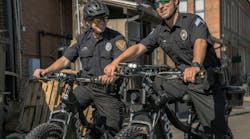Search and rescue operations may normally be the bailiwick of fire departments, but frequently we in law enforcement are called to assist. Sometimes we bring added manpower, other times we bring specialized equipment, such as helicopters or night vision devices.
Recently, police officers in the County of Kent, England, used a thermal imager to help locate a man who had wandered into the woods and was a risk to himself. Constable Martin Pemble contacted me about their success and agreed to an interview regarding the event. While our brothers (and sisters) in the UK may talk funny, their police work is similar to ours in the U.S. Kent's success in a search can be duplicated in almost any jurisdiction on this side of the Atlantic Ocean.
Constable Pemble, what happened in the rescue? On May 3rd, we had a callout for a despondent male subject. He was possibly suicidal after consuming unknown quantities of drugs and alcohol. He had been missing since 1315 and was last seen going into a heavily wooded area. It was 1900 and starting to get dark when I got called; I am the Search Manager for Missing Persons. I deployed several units to form a containment perimeter and deployed a thermal imager with the Tactical Team. Due to low cloud cover, the promised helicopter failed to appear. Shortly after 2215, we located the male face down off a track using the thermal imager.
Although his total time missing was nine hours, our active search took only three hours. Seeing as the outside temperature was about seven degrees [44 degrees to us Americans], and he was dressed in a t-shirt and shorts, I am confident that without the thermal imager, he would be dead. He would not have been found without the deployment of this equipment.
Could you describe your agency?
I work for Kent Police, which is a force of 3,500 officers. We cover the county of Kent, which is in the southeast corner of the UK, bordering London to the North. The county's population is about 1.3 million people.How many thermal imagers do you have and how long have you had them? We have six deployed throughout the county; there is one at every main station. They are placed there for geographical reasons so that officers from units such as Tactical Teams or Search Managers can have access to them without having to hunt around the county. Our area DLOs (Drug Liaison Officers) are responsible for storage and maintenance, as well as recording when we deploy the TIs. We have a booking out system to avoid issues of litigation or inappropriate use.
We have had the thermal imagers for about 6-7 months.
How have you used TIs prior to this successful search?
Prior to this deployment, I have used it on road checks and in training. We practiced in fields to try and work out the best way to interpret the image and to have a better working knowledge of the imager. We have also deployed it to try and locate skunk cannabis houses which have the disadvantage (for them) of giving off huge heat signatures.
[Note to American law enforcement: the US Supreme Court has restricted this type of use on a residence, ruling it a Fourth Amendment search. See Kyllo v. US, 2001]
How has the successful search changed fellow officers' approach to the TI?The search has altered officers' views, and the Force's. There is talk of senior officers getting more TIs, which would be of benefit to everyone. Officers do want to use it now, and it's deployed willingly to many events, including search warrants and missing person searches.
Finding lost civilians is not a regular request for us as American police officers. However, when we are asked to assist in a search and rescue operation, time is normally of the essence. The elements, lack of water, lack of food, injuries or any of a host of other complications make it critical to find lost people quickly.
Thermal imagers can help us do that, just as they did our brothers in the UK. Sure, British police don't wear the cool hats that we do, don't carry sidearms and don't drive cruisers with V-8 engines...but it doesn't mean we can't learn one or two things from them.


